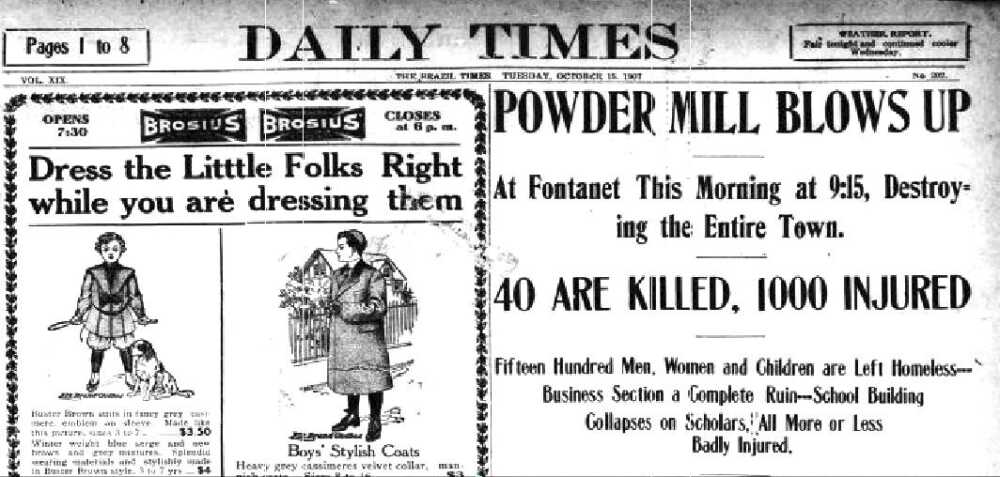Murder Series: A Hoosier’s War, Ch. 1 The Earth Moves

Chapter 1. The Earth Moves
On October 15, 1907, Clay County residents felt the ground shake under their feet and heard two enormous explosions, one at 9:08 a.m. and the second at 9:40 a.m. The DuPont Powder Mill, seven miles from Brazil as the crow flies and the main employer of the town of Fontanet in neighboring Vigo County, had blown up. The blasts destroyed not just the mill; they leveled most of Fontanet-- and killed dozens of people.
The next day’s Brazil Daily Times reported that “fully fifteen hundred people are homeless, and no less than one thousand more or less injured. Over five hundred homes, businesses, houses, churches, etc., are wrecked and every person is covered with either their own blood or that of the injured they have been caring for.” Clay County residents personally experienced the power of the blasts when windows in their homes and businesses broke, walls cracked, and buildings shifted off their foundations
People from 200 miles away heard the percussion of 40,000 kegs of powder. Newspapers from all over the country covered the disaster. What had been a bustling town of 1000 people became a shell akin to the villages in France and Belgium that would be destroyed in a war that was almost ten years away.
The people of Fontanet rebuilt the town but rejected DuPont’s offer to rebuild the powder mill, preferring the danger of working in nearby coal mines over the risk of another catastrophe. The ruins of the powder mill and the expanse of property around them reverted to a dense jungle-like forest. Parents from throughout the area would take their children there to hunt tadpoles, mushrooms, and salamanders and to look with reverence and a bit of fear at the enormous overgrown but still solid cement foundations of what had been.
When the powder mill exploded in 1907, Clifford Bouillez was 12 years old living on his family’s farm a couple of miles from Fontanet. He was one of 14 children;11 survived to adulthood. His father, Ozee, immigrated to the US in 1863 from Belgium, and his mother, born Christina Kimmerle, was a first generation American whose parents were German-born. The blast shook the Bouillez’s land and no doubt rocked the farm’s structures. Damage occurred inside homes, as well, and Christina might have been upset that the blast had caused items passed down to her from the old country to fall from counters and shelves.
Clifford seemed to be more inclined to farm work than his brothers, who were coal miners. It could well be that Clifford found his family a bit hard to take. A hot streak of bad temper ran in the Bouillez bloodline. It was rumored that one of Clifford’s sisters was so hard to live with that her husband killed himself by drinking carbolic acid as his only way to escape her.
By 1917, Clifford was a short, handsome man known to most as “Kink” because of the tight curls in his black hair. When he registered for the draft on June 5th of that year, he was living in Carbon in Clay County but was still working the family farm, helping to support Ozee, who had a daughter and her family living with him.
Perhaps boredom with farm life triggered Kink’s decision to join the US Army in 1918 while World War II raged in Europe. He was 26 years old and single, stuck in a rut, his mother dead for three years, his father an old man, and his brothers and sisters married with families of their own. Maybe he saw the army as a way to see the world that his father had left when he came to the US.
